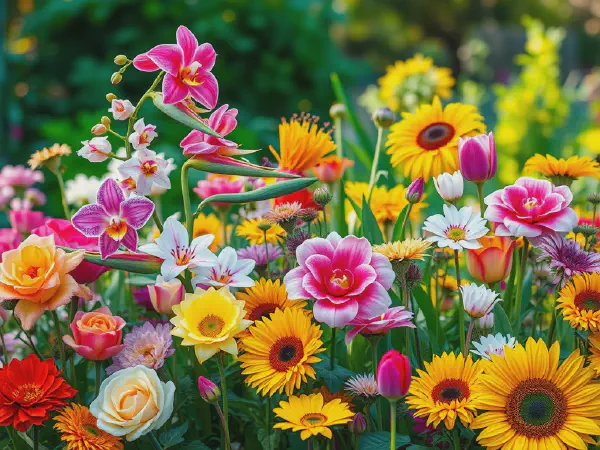Exploring Different Types of Flowers: A Comprehensive Guide

Exploring the Beautiful Diversity of Types of Flowers
Flowers are among the most beautiful and diverse creations of nature. From the gentle blooms of wildflowers to the exquisite elegance of tropical flowers, there are countless types of flowers that captivate our senses and enrich our lives. This article delves into the different types of flowers, their characteristics, and the roles they play in our ecosystems and environments.
Different types of flowers can be categorized into several groups such as annuals, perennials, wildflowers, tropical flowers, and ornamental flowers. Each category has its unique features, growing requirements, and benefits. Understanding these types of flowers helps gardeners, landscapers, and nature enthusiasts select the right flowers for their needs and appreciate the diversity of the plant kingdom.
The types of flowers you choose can greatly influence the aesthetic and ecological value of a garden or landscape. Annual flowers, for instance, are prized for their vibrant colors and ability to bloom throughout the growing season. In contrast, perennial flowers offer a long-lasting presence in the garden, returning year after year. Wildflowers bring a natural beauty and support local wildlife, while tropical flowers add exotic appeal. Ornamental flowers, on the other hand, are chosen primarily for their visual appeal and use in landscape design.
Each type of flower has specific growing conditions and care requirements. Annuals thrive in full sun and well-draining soil, while perennials may need more varied conditions depending on the species. Wildflowers often adapt well to local environments, making them low-maintenance choices for natural gardens. Tropical flowers, requiring warmer climates, demand specific soil and humidity levels. Lastly, ornamental flowers can be grown in various conditions but require thoughtful planning to create cohesive designs.
Understanding the types of flowers available can help you make informed decisions in gardening, landscaping, and conservation efforts. By appreciating their diversity and ecological roles, we can nurture our environments and ensure the beauty of flowers continues to enrich our lives for generations to come.
Annual Flowers: Bright and Vibrant
Annual flowers are plants that complete their life cycle within a single growing season. They germinate, flower, seed, and die all in one year, making them a popular choice for gardeners looking for bursts of color and variety.
Some popular types of annual flowers include marigolds, petunias, zinnias, and pansies. These flowers are favored for their vibrant hues and long blooming periods, often used to create stunning floral displays throughout the growing season.
Best care practices for annual flowers include ensuring consistent watering, providing adequate sunlight, and deadheading spent blooms to encourage further flowering. Regular fertilization can also promote healthier growth and more vibrant blooms.
Annual flowers are often used in landscaping for seasonal color, creating borders, and filling in gaps in gardens. They are also commonly used in container gardening to add splashes of color to patios and balconies.
Perennial Flowers: Lasting Beauty
Perennial flowers are plants that live for more than two years, often returning each spring to bloom again. They typically go through a cycle of growth, flowering, and dormancy, allowing them to adapt to changing seasons.
Some top perennial flowers for gardens include peonies, daylilies, coneflowers, and hostas. These flowers are popular for their longevity and seasonal changes, offering different visual appeal throughout the year.
Maintenance tips for perennial flowers involve regular pruning, mulching to retain moisture, and dividing established plants every few years to encourage robust growth. Proper care can ensure they thrive for years in your garden.
Seasonal blooming patterns of perennials mean that gardeners can enjoy different flowers throughout the growing season. Early bloomers like crocuses herald the end of winter, while late bloomers like asters provide color well into fall.
Wildflowers: Nature's Charm
Wildflowers are plants that grow naturally in the wild without human intervention. They play an important role in local ecosystems by providing food and habitat for wildlife and pollinators.
Common types of wildflowers include black-eyed Susans, lupines, and bluebells. These flowers are often found in meadows, fields, and along roadsides, adding natural beauty to the landscape.
Wildflower habitats and ecosystems can be diverse, ranging from coastal dunes to mountainous regions. They thrive in these natural environments and help maintain soil health, prevent erosion, and support wildlife diversity.
Conservation of wildflower species is crucial for maintaining biodiversity and healthy ecosystems. Efforts to protect their habitats, promote native planting, and educate communities about the importance of wildflowers contribute to their survival.
Tropical Flowers: Exotic Beauty
Tropical flowers are known for their vibrant colors, unique shapes, and lush foliage. They thrive in warm, humid climates and are often associated with exotic locations and tropical environments.
Examples of popular tropical flowers include hibiscus, orchids, and plumeria. These flowers are often used in ornamental displays and can add a touch of paradise to gardens and landscapes.
Growing conditions for tropical flowers typically require well-draining soil, high humidity, and plenty of sunlight. Gardeners must often mimic their natural environments to ensure these flowers thrive outside their native habitats.
The role of tropical flowers in culture is significant, often symbolizing beauty, love, and celebration in various cultures. They are used in traditional ceremonies, floral arrangements, and as ornamental plants in homes and gardens.
Ornamental Flowers: Designed Beauty
Ornamental flowers are specifically grown for decorative purposes rather than for consumption or utility. They are often integrated into landscape designs to enhance visual appeal.
Types of ornamental flowers include roses, tulips, and dahlias. These flowers are chosen for their aesthetic qualities, providing color, texture, and fragrance to gardens and landscapes.
Seasonal trends in ornamental flowers are important for gardeners who want to keep their landscapes fresh and appealing. Different flowers come into season at various times, allowing for continuous blooms throughout the year.
Caring for ornamental flowers in gardens involves proper watering, fertilization, and pest control. Designers often consider the growth habits and visual impact of these flowers to create cohesive and inviting outdoor spaces.
